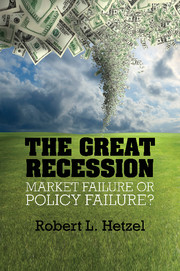Book contents
- Frontmatter
- Contents
- Figures
- Tables
- Preface
- One The 2008–2009 Recession
- Two Recessions
- Three The Great Contraction
- Four Monetary Policy and Bank Runs in the Great Depression
- Five Vigorous Recovery and Relapse
- Six Interwar International Monetary Experiments
- Seven Identifying the Shocks that Cause Recessions
- Eight From Stop-Go to the Great Moderation
- Nine Controlling Bank Risk Taking
- Ten The Housing Crash
- Eleven Bubble Trouble
- Twelve What Caused the Great Recession of 2008–2009?
- Thirteen What Caused the Great Leverage Collapse?
- Fourteen The Distinctions Between Credit, Monetary, and Liquidity Policy
- Fifteen Fed Market Interventions
- Sixteen Evaluating Policy
- Seventeen The Business Cycle
- Eighteen Why Is Learning So Hard?
- Nineteen How Should Society Regulate Capitalism?
- Postscript
- Bibliography
- Index
- References
Nine - Controlling Bank Risk Taking
Market or Regulator Discipline?
Published online by Cambridge University Press: 05 May 2012
- Frontmatter
- Contents
- Figures
- Tables
- Preface
- One The 2008–2009 Recession
- Two Recessions
- Three The Great Contraction
- Four Monetary Policy and Bank Runs in the Great Depression
- Five Vigorous Recovery and Relapse
- Six Interwar International Monetary Experiments
- Seven Identifying the Shocks that Cause Recessions
- Eight From Stop-Go to the Great Moderation
- Nine Controlling Bank Risk Taking
- Ten The Housing Crash
- Eleven Bubble Trouble
- Twelve What Caused the Great Recession of 2008–2009?
- Thirteen What Caused the Great Leverage Collapse?
- Fourteen The Distinctions Between Credit, Monetary, and Liquidity Policy
- Fifteen Fed Market Interventions
- Sixteen Evaluating Policy
- Seventeen The Business Cycle
- Eighteen Why Is Learning So Hard?
- Nineteen How Should Society Regulate Capitalism?
- Postscript
- Bibliography
- Index
- References
Summary
The financial safety net that protects the debt holders and depositors of financial institutions from losses came sharply into view on March 15, 2008, with the bailout of Bear Stearns’ creditors. The New York Fed assumed the risk of loss for $30 billion (later reduced to $29 billion) of assets held in the portfolio of the investment bank Bear Stearns as inducement for its acquisition by JPMorgan Chase. In addition, it opened the discount window to primary dealers in government securities, some of which were part of investment banks rather than commercial banks. The rationale for the bailout was prevention of the systemic risk of a cascading series of defaults brought about by wholesale withdrawal of cash investors from money markets. At the same time, there was also recognition of how a financial safety net creates moral hazard, that is, an increased incentive to risk taking (Lacker 2008). Given the twin goals of financial stability and mitigation of moral hazard, what regulatory regime should emerge from the 2008–2009 recession?
Such a regime must address the consensus that financial institutions took on excessive risk in the period from 2003 to summer 2007. They did so through the use of leverage involving borrowing short-term, low-cost funds to fund long-term, illiquid, risky assets. However, should the limitation of risk taking come from increased oversight by government regulators or should it come from the enhanced market discipline that would follow from sharply curtailing the financial safety net? Each alternative raises the issue of trade-offs. Does the optimal mix of financial stability and minimal moral hazard lie with an extensive financial safety net and heavy government regulation of the risk taking encouraged by moral hazard? Alternatively, does the optimal mix lie with a limited financial safety net and the market monitoring of risk taking that comes with the possibility of bank runs but combined with procedures for placing large financial institutions into conservatorship with losses imposed on debt holders?
- Type
- Chapter
- Information
- The Great RecessionMarket Failure or Policy Failure?, pp. 149 - 169Publisher: Cambridge University PressPrint publication year: 2012



